Slavs
Slavs, name of a people (communication community), speakers of an Indo-European language. Between the 6th and the 7th c. they spread across a great territory in Europe, from Ukraine in the east to the Balkans in the south, the river Unstrut, possibly even the Upper Main, in the west, and Schleswig Holstein in the north-west (map 1-2.). Their migrations during the 6th-8th century are relatively poorly illuminated by the written sources nevertheless Slavicisation of vast tracts of Europe is an important aspect of the →Migration Period studies.
The name is recorded for the first time in Greek and Latin sources during the first half of the 6th century as: Σκλαβηνοι; Σκλαβοι; sclavi. It may be what the Slavs called themselves. The original form, is reconstructed by some as *slověne; perhaps this has something to do with the Slav word slovo, which in Polish still means ‘word’ and ‘language’. During the Middle Ages Slavs are sometimes also referred to as “Wends, from the Antique Veneti (cf. Germanic Wenden, Finnish Venäja)
The earliest written record on S., from around 550 AD is in →Cassiodorus, his work known from its summary, handed down by →Jordanes (Getica), and →Procopius of Caesarea (especially, his De bello Gothico). Both Jordanes and Procopius report that Slavs were divided into Sclaveni and Antae; Jordanes mentions also the race of the Venethi whom he considers an earlier name of the people, or possibly, a tribe contemporary to the Sclaveni and Antae (Getica, V.34-35, p. 16). From Procopius we learn that the Sclaveni and Antae were known originally as Spori, or Sporoi (De bello Gothico III.14, p. 272-273).
According to →Jordanes the Sclaveni lived in the lands to the north of the Danube, as far as the Upper Vistula in the west and the Dniester in the east (map 1-2.); the territory of the Antae extended east from the Dniester to the Dnieper (Getica, V.34-35, p. 16). If we accept that Antae indeed were Slavs, then the first Slav ruler known from the written record was Boz, defeated in late 4th century by Vinitharius of the →Ostrogoths (Getica, XLVIII.246-247, p. 101-102).
According to the Byzantine records in the second half of 6th and during the 7th century Slavs moved into the Balkans. Archaeological evidence on their presence in that region is rather modest. Two of the earliest, reliably dated archaeological sites to confirm Slavicisation are the settlement at Pristava near Bled in Slovenia (6th-7th c.) and a Slav cemetery at Olympia in Peloponnesus datable to 7th-8th c.
In the study of Slav presence in Central Europe a key role is played by archaeological sources, the written record of →Jordanes (on the migration of the →Heruli ) and of →Theophylact Simocatta is much more modest and not fully reliable.
The problem of the location of the earliest archaeological cultures which may be identified with the Slavs is one of the most controversial in Central European archaeology, not the least in Polish archaeology. The autochthonists argue that Slavs were established on the territory of present day Poland before the →Migration Period ; the allochthonists claim that they came to this region, from East Europe, only during the second half of the 5th and in the 6th century.
According to the allochtonists one of the earliest cultures associated with the Slavs is Prague culture, with some sites recorded also in Poland, and Penkovka culture of the forest-steppe zone in Ukraine and Moldavia. These two cultures share a number of features: 1). the system of settlement, with no fortified settlements; on the territory occupied by Prague culture the distinctive form of dwelling is a square-shaped pit hut with a stove in one corner; 2). an economic model, dominated by agriculture, with poorly developed crafts, the pottery plain and hand-built (the first wheel-made vessels appear only in the 7th c.); 3). very limited exchange with the outside world indicated by only a small number of imported objects; 4). the burial rite – cremations deposited in pits, urned or not, with little or no grave goods.
Two archaeological units found east and north of Penkovka culture - Kolochin culture, occupying the left bank of the Middle Dnieper and the Desna Basin, and Bantserovshchina-Tushemla culture located on the Upper Dnieper, the Neman and the Daugava, are recognized by some researchers as early Slav cultures. All four cultures named here are dated to 6th-7th c. It is possible Kiev culture, established in the period 2nd to 5th cc. on the Upper and Middle Dnieper, evolved in late 4th-5th c. into Kolochin culture and Penkovka culture and played a major significant role in the emergence of Prague culture.
In mid-6th century the territory of Prague culture extended westward only to the line of the Vistula and a little beyond that river, in the second half of the 6th c. the process of Slavicisation of Bohemia and Slovakia began; presumably, a significant role in this process was the withdrawal from the Carpathian Basin of →Gepids and →Langobards, who were replaced by the →Avars (568).
Slavicisation of the region to the west and north-west of the Vistula took place not – as was thought until recently – during the 6th century but much later. A series of dendrology dates from East Germany (e.g., from the settlement site at Schmerzke near Brandenburg an der Havel) and from Poland (e.g., the settlement site at Polwica in Silesia) proves that this took place only in late 7th and early 8th century.
In its traditional version (J. Kostrzewski) the autochthonist theory assumed the continuity of settlement on the territory of today’s Poland going back at least to the Bronze Age, and within this scheme Lusatian culture and its signature site at Biskupin were attributed to the Proto-Slavs. At present this view is much less widespread. Nevertheless, attention is drawn to some analogies observable in the Roman period and medieval pottery (T. Makiewicz) and, even more importantly, to the methodological weakness of the allochthonist approach such as excessive confidence place in the ethnic attribution of artefacts or archaeological cultures. This is a charge which is being levelled not just to the study of the origins of the Slavs, it is an element of a wider discussion in European archaeology addressing its methodological grounds.
A major controversy was sparked by the arguments of Florin Curta, American historian, most notably his claim that the name (Sclavenes) should be viewed as a construct of the Byzantine authors designed to make sense of a complicated configuration of ethnic groups on the northern frontier. The arguments of F. Curta have triggered a lively discussion and, needless to say, criticism of Central European archaeologists.
In Poland the key sites associated with Slav beginnings include a settlement at Bachórz on the river San investigated on a regular basis by M. Parczewski and a complex of settlements on the Vistula River: Kraków – Nowa Huta Wyciąże (fig. 1-2.), site 5B, with a pit-hut from the first half of the 7th c. (dendrology dates) and Kraków – Nowa Huta Mogiła, site 62 A, with a hoard of 6th/7th c. ornaments (fig. 3.).
The largest early Slav settlement in Central Europe is recorded in the Czech Republic, at Roztoky near Prague with some 330 dwellings.
MW
Written sources: Iordanis de origine actibusque Getarum, F. Giunta, A. Grillone (ed.), Roma 1991; Procopius of Caesarea, Procopius IV, History of the Wars. Books VI. 16 - VII. 35, H. B. Dewing (ed.), LOEB 173, Cambridge-London 1924.
Literature: K. Godłowski, Z badań nad zagadnieniem rozprzestrzenienia Słowian w V-VII w. n.e., Kraków 1979; M. Parczewski, Początki kultury wczesnosłowiańskiej w Polsce. Krytyka i datowanie źródeł archeologicznych, Prace Komisji Archeologicznej, 27, Wrocław 1988; M. Parczewski, Najstarsza faza kultury wczesnosłowiańskiej w Polsce, Rozprawy habilitacyjne UJ, 141, Kraków 1988; H. Popowska-Taborska, Wczesne dzieje Słowian w świetle ich języka, Wrocław 1991; M. Parczewski, Die Anfänge der frühslawischen Kultur in Polen, Veröffentlichungen der Österreichischen Gesellschaft für Ur- und Frühgeschichte, 17, Wien 1993; K. Godłowski, Pierwotne siedziby Słowian. Wybór pism (M. Parczewski ed.), Kraków 2000; T. Vida, T. Völling, Das slawische Brandgräberfeld von Olympia, Archäologie in Eurasien, 9, Rahden/Westfalen 2000; S. Brather, Archäologie der Westslawen. Siedlung, Wirtschaft und Gesellschaft im früh- und hochmittelalterlichen Ostmitteleuropa, Ergänzungsbände zum Reallexikon der Germanischen Altertumskunde, 30, Berlin – New York 2001; F. Curta, The Making of the Slavs. History and Archaeology of the Lower Danube Region, c. 500-700, Cambridge 2001; M. Dulinicz, Kształtowanie się Słowiańszczyzny Północno-Zachodniej. Studium archeologiczne, Warszawa 2001; S. Brather, Ethnische Interpretation in der frügeschichtlichen Archäologie. Geschichte, Grundlagen und Alternativen, Ergänzungsbände zum Reallexikon der Germanischen Altertumskunde, 42, Berlin – New York 2004; Frühe Slawen in Mitteleuropa. Schriften von Kazimierz Godłowski, J. Bemmann, M. Parczewski (eds.), Studien zur Siedlungsgeschichte und Archäologie der Ostseegebiete, 6, Neumünster 2005; M. Kuna, N. Profantova, et al., Počátky raného středověku v Čechách: archeologický výzkum sídelní aglomerace kultury pražského typu v Roztokách, Praha 2005; M. Parczewski, P. Kaczanowski (eds.), Archeologia o początkach Słowian, Kraków 2005 (688 pp., overview of status of research and views on the origin of S.; with a discussion of conference participants); M. Dulinicz, Frühe Slawen im Gebiet zwischen unterer Weichsel und Elbe. Eine archäologische Studie, Studien zur Siedlungsgeschichte und Archäologie der Ostsseegebiete, 7, Kiel 2006 ; P. Urbańczyk (eds.), Nie-Słowianie o początkach Słowian, Poznań-Warszawa 2006 (210 pp.; including the only Polish version of F. Curta’s text on the origin of S.); S. Tabaczyński, A. Marciniak, D. Cyngot, A. Zalewska (eds.), Przeszłość społeczna. Próba konceptualizacji, Poznań 2012 (1330 pp., with some notable contributions on the subject of ethnicity in archaeology, e.g., W. Duczko, S. Jones, P. Urbańczyk); M. Dulinicz, S. Moździoch (eds.), The Early Slavic Settlement of Central Europe in the light of new dating evidence, Interdisciplinary Medieval Studies, 3, Wrocław 2013 (260 pp., with some notable publications concerned with the Balkans); M. Mączyńska, Światło z popiołu. Wędrwówki ludów w Europie w IV i V w., Warszawa 2013, p. 272-279.
In-depth studies: J. Kolendo, Wenetowie w Europie Środkowej i Wschodniej. Lokalizacja i rzeczywistość etniczna, Przegląd Historyczny, 75 (1984), pp. 637-653 (reprinted in: J. Kolendo, Świat antyczny i barbarzyńcy. Teksty, zabytki, refleksja nad przeszłością, Warszawa 1998, t. I, pp. 95-106); E. Dąbrowska, Skarb ozdób z VI-VII w. na stanowisku 62A w Nowej Hucie-Mogile, Archeologia Polski, t. 29 (1984), pp. 351-369; F. Biermann, S. Dalitz, K.-U. Heussner, Der Brunnen von Schmerzke, Stadt Brandenburg a.d. Havel, und die absolute Chronologie der frühslawischen Besiedlung im nordostdeutschen Raum, Prähistorische Zeitschrift, 74:2, 1999, pp. 219-243; M. Parczewski, Kultury archeologiczne a teoria wspólnot komunikatywnych, [in:] St. Tabaczyński (eds.), Kultury archeologiczne a rzeczywistość dziejowa, Warszawa 2000, pp. 207-213; M. Parczewski, Podstawy lokalizacji pierwotnych siedzib Słowian, [in:] M. Parczewski, P. Kaczanowski (eds.), Archeologia o początkach Słowian, Kraków 2005, pp. 65-78; P. Poleska, J. Bober, M. Krąpiec, Wczesnosłowiańska półziemianka z osady w Wyciążu, stanowisko 5B, w Krakowie Nowej Hucie, [in:] M. Parczewski, P. Kaczanowski (eds.), Archeologia o początkach Słowian, Kraków 2005, pp. 605-609; St. Turlej, Upadek granicy Cesarstwa na Dunaju, [in:] St. Turlej (eds.), Barbarzyńcy u bram Imperium, Kraków 2007, pp. 185-246; A. Lambropoulou, The Presence of Slavs in the Western Peloponnese during the 7th and 8th Centuries: New Archaeological Evidence, [in:] D. Quast (eds.), Foreigners in Early Medieval Europe, Monographien des Römisch-Germanischen Zentralmuseums, 78, Mainz 2009, pp. 197-217; B. Sz. Szmoniewski, The Antes: Eastern ‘Brothers’ of the Sclavenes? [in:] F. Curta (eds.), Neglected Barbarians, Studies in the Early Middle Ages, 32, Turnhout 2010, pp. 53-82.
-
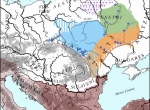 full resolution
full resolution
Map 1. Slavs (Sclaveni and Anti) during the first half of the 6th century – evidence from archaeological and written evidence; from M. Parczewski (2005, Fig. 1), redrawn by I. Jordan. a – Prague culture; b – Penkovka culture; c – Kolochin culture; d – Bant
-
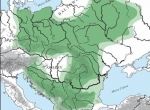 full resolution
full resolution
Map 2. Slavs in the 8th century; from M. Parczewski (2005, Fig. 4), redrawn by I. Jordan. a – Slav territory; b – border areas with an ethnically mixed population.
-
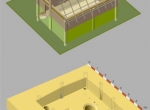 full resolution
full resolution
Fig. 1. Kraków – Nowa Huta Wyciąże, site 5B, feature no. 1 – Early Slav pit-hut; from P. Poleska, J. Bober, M. Krąpiec (2005, Fig. 1), drawing J. Poleski. At bottom – axonometric projection, at top – the construction technique.
-
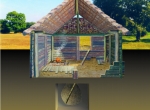 full resolution
full resolution
Fig. 2. Kraków – Nowa Huta Wyciąże, site 5B, feature no. 1 – Early Slav pit-hut (reconstruction of interior); from P. Poleska, J. Bober, M. Krąpiec (2005, Fig. 1), drawing J. Poleski.
-
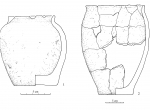 full resolution
full resolution
Fig. 3. Early Slav pottery; from M. Parczewski (1993, Plate VIII:1, XVIII:15) redrawn by J. Ożóg. 1 – Maćkówka, site 2, Przeworsk district; 2 – Kraków – Nowa Huta Mogiła, site 62A, feature 45/66 (the vessel – container of the bronze hoard, see Fig. 6).
-
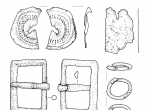 full resolution
full resolution
Fig. 4. Kraków – Nowa Huta Mogiła, site 62 A, feature no. 45/66. Bronze hoard; from E. Dąbrowska (1984, Fig. 3) redrawn by J. Ożóg.
-
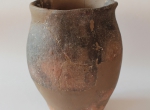 full resolution
full resolution
Fig. 5. Early Slav pottery vessels – Prague type pottery from the settlement in Krakow Nowa Huta Mogiła (phot. by A. Susuł)
-
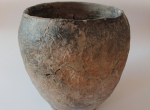 full resolution
full resolution
Fig. 6. Early Slav pottery vessels - Dziedzice/ Sukow type pottery from the settlement in Dziedzice, Myślibórz District (phot. T. Otulak)


